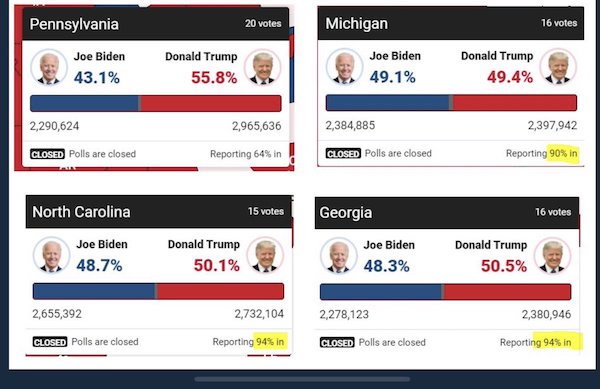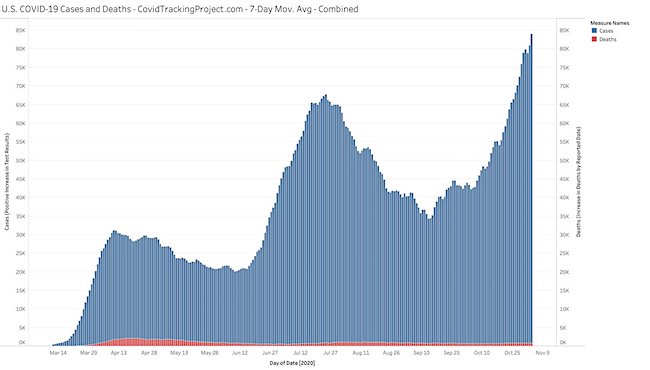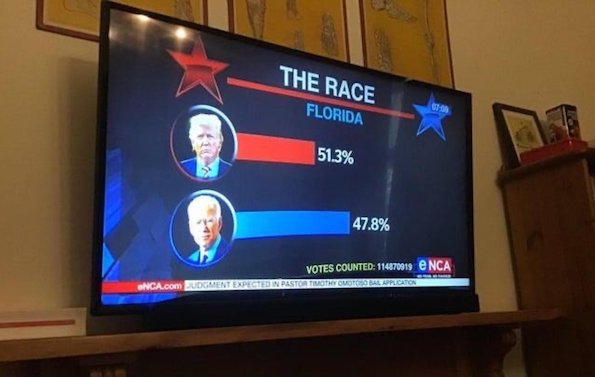
Pablo Picasso Bull plates I-XI 1945

There is this odd divide between the presidential vote, which Biden may win, and all the other votes, where the GOP candidates are doing much better than expected, and taking back House seats. How is that possible?



Happy lawyers.
• Trump Goes To Supreme Court, Files Lawsuits To Stop Vote Counting In PA (F.)
The Trump campaign is filing multiple lawsuits in Pennsylvania targeting the state’s rules for election observers and mail-in ballots, as well as intervening in an ongoing U.S. Supreme Court case regarding the state’s mail-in ballot deadline, the campaign said Wednesday, ramping up the GOP’s legal efforts in the battleground state as the race between President Donald Trump and Joe Biden narrows. The Trump campaign said in a statement Wednesday that it is suing Pennsylvania to stop the state from “hiding the ballot counting and processing from our Republican poll observers,” specifically mentioning a policy that requires poll watchers to stand 25 feet from where the counting process is taking place.
The campaign is appealing a case that previously failed in a lower court in Philadelphia to the Pennsylvania Commonwealth Court, which alleged an election observer could not “observe the writing on the outside of the ballots.” The Trump campaign and Republican National Committee sued state and local officials over a practice in which mail-in voters are allowed to provide proof of identification after the ballot deadline if it was initially missing, which Secretary of State Kathy Boockvar recently extended by an additional three days to November 12. Republicans claim allowing voters to provide identification through that date will “create a high risk of jeopardizing the integrity” of the election by delaying election results, and are calling for the court to throw out any ballots where the voter’s identification isn’t received by the original deadline of Nov. 9.
The Trump campaign also filed a motion to intervene in an ongoing U.S. Supreme Court case regarding the state’s mail-in ballot deadline, which allows mail-in ballots to be counted if they’re delivered up to three days after Election Day.The Supreme Court previously declined to overturn the extended deadline before Election Day—in a 4-4 ruling before Justice Amy Coney Barrett joined the court—but several conservative justices said the court could still revisit the ruling and invalidate the deadline, which would result in any late-arriving ballots being rejected.
Trump to win Arizona
The actual math points to an Arizona win for Pres Trump, here are the numbers.
Patriots, stay confident, and stay the course! #ChalkTalkpic.twitter.com/wIFUSt4XKW
— Steve Cortes (@CortesSteve) November 5, 2020

“President Trump’s campaign has not been provided with meaningful access to numerous counting locations to observe the opening of ballots and the counting process.”
“President Trump is committed to ensuring that all legal votes are counted in Michigan and everywhere else.”
• Trump Assembling All-star Legal Team To Mount Election Challenges (JTN)
President Trump’s campaign on Wednesday began assembling an all-star legal team to file challenges to election regularities in several battleground states, starting with a Court of Claims lawsuit in Michigan. Among the lawyers the president is activating include his private attorney Jay Sekulow, who will help campaign lawyers with matters before the Supreme Court as well as former New York City Mayor Rudy Giuliani and former Florida Attorney General Pam Bondi, officials said. Sidney Powell, the lawyer for former National Security Adviser Michael Flynn, may also be called upon, officials said. The legal team’s first stop was Michigan, where the campaign filed an action in the Court of Claims seeking to halt vote counting until irregularities are addressed, campaign manager Bill Stepien announced.
“As votes in Michigan continue to be counted, the presidential race in the state remains extremely tight as we always knew it would be. President Trump’s campaign has not been provided with meaningful access to numerous counting locations to observe the opening of ballots and the counting process, as guaranteed by Michigan law,” Stepien said. “We have filed suit today in the Michigan Court of Claims to halt counting until meaningful access has been granted. We also demand to review those ballots which were opened and counted while we did not have meaningful access. President Trump is committed to ensuring that all legal votes are counted in Michigan and everywhere else.”


“..the monumental failures of the polling industry and the data nerds who leech off it, for the second consecutive national election, only serve to sow even further doubt and confusion..”
• US Inability To Count Votes is a National Disgrace. And Dangerous (Greenwald)
Nations far poorer and less technologically advanced have no problem holding quick, efficient elections. Distrust in U.S. outcomes is dangerous but rational. The richest and most powerful country on earth — whether due to ineptitude, choice or some combination of both — has no ability to perform the simple task of counting votes in a minimally efficient or confidence-inspiring manner. As a result, the credibility of the voting process is severely impaired, and any residual authority the U.S. claims to “spread” democracy to lucky recipients of its benevolence around the world is close to obliterated. At 7:30 a.m. ET on Wednesday, the day after the 2020 presidential elections, the results of the presidential race, as well as control of the Senate, are very much in doubt and in chaos.
Watched by rest of the world — deeply affected by who rules the still-imperialist superpower — the U.S. struggles and stumbles and staggers to engage in a simple task mastered by countless other less powerful and poorer countries: counting votes. Some states are not expected to finished their vote-counting until the end of this week or beyond. The same data and polling geniuses who pronounced that Hillary Clinton had a 90% probability or more of winning the 2016 election, and who spent the last three months proclaiming the 2020 election even more of a sure thing for the Democratic presidential candidate, are currently insisting that Biden, despite being behind in numerous key states, is still the favorite by virtue of uncounted ballots in Democrat-heavy counties in the outcome-determinative states.
[One went to sleep last night with the now-notorious New York Times needle of data guru Nate Cohn assuring the country that, with more than 80% of the vote counted in Georgia, Trump had more than an 80% chance to win that state, only to wake up a few hours later with the needle now predicting the opposite outcome; that all happened just a few hours after Cohn assured everyone how much “smarter” his little needle was this time around].
NYT needle showing 71% chance of Trump winning North Carolina now, "leaning Trump". 82% chance of him winning Georgia, "probably Trump". https://t.co/yIRJQIMf70 pic.twitter.com/iYoo4bOYeX
— Doge (@IntelDoge) November 4, 2020
NYT’s predictive needle for Georgia at 8:40 pm ET, Tuesday night.
https://twitter.com/TravisAllen02/status/1323855693359861762
NYT’s predictive needle for Georgia less than four hours later, at 12:12 a.m., early Wednesday morning.
Given the record of failures and humiliations they have quickly compiled, what rational person would trust anything they say at this point? A citizen randomly chosen from the telephone book would be as reliable if not more so for sharing predictions. And the monumental failures of the polling industry and the data nerds who leech off it, for the second consecutive national election, only serve to sow even further doubt and confusion around the electoral process. A completely untrustworthy voting count is now the norm. Two months after the New York state primary in late June, two Congressional races were in doubt by what The New York Times called “major delays in counting a deluge of 400,000 mail-in ballots and other problems.” In particular: Thousands more ballots in the city were discarded by election officials for minor errors, or not even sent to voters until the day before the primary, making it all but impossible for the ballots to be returned in time.

“..a 2020 election night awash with Democratic disappointment..”
• How The GOP Retook House Seats From Democrats (F.)
Republicans wrested at least seven U.S. House seats from Democrats this year, retaking districts the party lost in 2018 and expanding slightly into blue territory, a surprising set of victories that could narrow the House’s thin 14-vote Democratic majority. Republicans have won back six moderate rural and suburban districts that Democrats took from the GOP in 2018 — in New Mexico, South Florida, Oklahoma, South Carolina and Iowa — reversing some of the Democrats’ gains from two years ago.In two of those districts, this year’s races were rematches of 2018, featuring the same candidates but different outcomes: Rep. Donna Shalala (D-Fla.) defeated Republican Maria Elvira Salazar in 2018 but lost to her in 2020, and Rep. Xochitl Torres Small (D-N.M.) lost to Republican Yvette Herrell despite winning against her two years ago.
Republicans also took Minnesota’s rural, conservative-leaning seventh district, ousting moderate 30-year incumbent Rep. Collin Peterson (D) after a tough re-election battle. Meanwhile, Democrats picked up just two seats in North Carolina, defeating Republican nominees in a pair of new urban and suburban districts created after a court-ordered redistricting effort last year. Dozens of House districts remained too close to call Wednesday morning, as officials rush to count mail-in ballots. In particular, Republicans are vying to win back former Republican strongholds like Orange County, Calif. and Staten Island, N.Y.
Democrats flipped dozens of congressional districts from red to blue in 2018, part of a wave election that propelled the party to a House majority. Many of those suburban and rural districts were traditionally conservative but changed hands amid nationwide leftward momentum, making their status as Democratic seats tenuous at best. Still, Democrats hoped to extend those gains in 2020 by flipping several moderate seats, and pre-election polls indicated most voters favored Democrats over Republicans in local House races. But on a 2020 election night awash with Democratic disappointment, the party’s hopes of another Democratic wave in the House quickly faded, and Republicans ended up regaining some ground.

“The spate of Democratic losses were not limited to any one geographic region.”
• House Democrats Fall Way Short In Disappointing Night (Hill)
Speaker Nancy Pelosi (D-Calif.) and her invigorated caucus charged into Tuesday with an energized base, a sharp fundraising advantage and hopes to flip anywhere from five to 15 Republican seats on election night. Instead, it was the Republicans who scored big — at least in the early counting — knocking out at least a half dozen vulnerable Democrats with several more clinging to the ropes. It was a reversal of fortunes for the Democrats, who had led big in the polls and the money race and were betting that President Trump at the top of the ticket would be a drag on GOP lawmakers all the way down the ballot. With gushing optimism, Democrats were expecting Tuesday night would give them a chance to pad their 232-197 majority next year.
“We’re well-positioned to have a good night,” Rep. Cheri Bustos (Ill.), head of the Democrats’ campaign arm, told reporters hours before polls closed Tuesday. As the sun came up Wednesday morning, however, there appeared few bright spots for Bustos’s party. While Democrats will retain their majority, a handful of their front-line members — incumbents facing the toughest races — had been defeated. And after boasting about how they’d expanded the map and were playing “deep into Trump country,” they’d failed to pick off even a single House Republican running for reelection. Democrats did manage to pick up a pair of GOP-held open seats in North Carolina, where redistricting had made the districts much bluer, and a third in Georgia after the retirement of vulnerable GOP Rep. Rob Woodall.
The spate of Democratic losses were not limited to any one geographic region. In rural Minnesota, Rep. Collin Peterson (D), a 15-term veteran and chairman of the Agriculture Committee, was clobbered by the state’s former lieutenant governor, who’d linked Peterson to the liberal Pelosi. In the suburbs of Oklahoma City, Rep. Kendra Horn (D), a first-term moderate, was defeated by Republican Stephanie Bice, a state senator, in one of the country’s most contested races. On New Mexico’s southern border, Rep. Xochitl Torres Small (D), a 36-year-old centrist also in her first term, fell to Yvette Herrell, a former state legislator, in a rematch of 2018. And in South Carolina, first-term Rep. Joe Cunningham (D) was ousted by state Rep. Nancy Mace (R).

And this is what comes next.
• Statehouse Wins Position GOP To Dominate Redistricting (Pol.)
Here’s something else Republicans can be happy about after Tuesday. An abysmal showing by Democrats in state legislative races on Tuesday not only denied them victories in Sun Belt and Rust Belt states that would have positioned them to advance their policy agenda — it also put the party at a disadvantage ahead of the redistricting that will determine the balance of power for the next decade. The results could domino through politics in America, helping the GOP draw favorable congressional and state legislative maps by ensuring Democrats remain the minority party in key state legislatures. Ultimately, it could mean more Republicans in Washington — and in state capitals.
By Wednesday night, Democrats had not flipped a single statehouse chamber in its favor. And it remained completely blocked from the map-making process in several key states — including Texas, North Carolina and Florida, which could have a combined 82 congressional seats by 2022 — where the GOP retained control of the state legislatures. After months of record-breaking fundraising by their candidates and a constellation of outside groups, Democrats fell far short of their goals and failed to build upon their 2018 successes to capture state chambers they had been targeting for years. And they may have President Donald Trump to blame. “It’s clear that Trump isn’t an anchor for the Republican legislative candidates. He’s a buoy,” Christina Polizzi, a spokeswoman for the Democratic Legislative Campaign Committee, said Wednesday.
“He overperformed media expectations, Democratic and Republican expectations, and lifted legislative candidates with him.” Democrats had a disappointing night in congressional and state legislative races across the country, as they realized the suburban revolt against Trump did not extend in 2020. Republicans appear poised to hold on to the Senate, gain seats in the House and pick up a governorship in Montana, defying expectations. But it is the victories they won in state legislatures could be the most consequential of all, giving the GOP outsize influence over the congressional and legislative redistricting process that begins early next year.

“Let’s not forget the rather reckless remark made by PA Attorney General Josh Shapiro on Halloween night that “if all the votes are added up, Mr. Trump is going to lose.“
• Election Update, 9:50 am Weds Nov 4 (Jim Kunstler)
The election has rolled out as expected here – that is, not resolved the morning after, with Antifa and BLM rioters already moiling in the streets of Washington D.C.Portland, Oregon, remains in continual uproar after four months of violence and destruction, and Mayor Ted Wheeler won reelection against “Antifa candidate” Sarah Iannarone. Lucky Portland. Outside the swing states still in play, the margins were strikingly lopsided. Joe Biden’s radiant charisma worked in the usual blue coastal states — Cal 65% to 33%, NY 55% to 33% — but Mr. Trump’s margins were equally lopsided in the flyover red states — OK 65% to 32%, TN 60% to 37%, MO 56% to 41%. Mr. Biden won thumpingly in VA once the Deep State bedroom counties next to DC came in late at night. But the president won convincingly in FLA, OH, and TX.
For now, at 9 a.m. Weds, the race hinges on the usual suspects. Mr. Trump is up a half a percent in Michigan with 91% of votes counted; Mr. Biden is seven-tenths up in Wisconsin, with 95% in… awaiting Green Bay results (delayed, apparently, because a vote-processing machine ran out of ink (!). Similar close margins in NC… not so close in GA, with the president ahead a healthy 2 percent, and finally the dark maw of mischief, PA, where Mr. Trump was up by more than ten full percentage points (@700,000 votes) this morning, but awaiting more than a million mail-in ballots. Let’s not forget the rather reckless remark made by PA Attorney General Josh Shapiro on Halloween night that “if all the votes are added up, Mr. Trump is going to lose.” Sounded pretty sure of himself.
Now, as I understand it, the PA state supreme court ruled recently that counties could continue to process mail-in votes until Friday, and, more importantly, that they did not require postmarks or signature authentication — which would appear an easy invitation to simple ballot fraud. The president vowed late Tuesday night to take a case to the US supreme court where, I expect, that PA ruling will be tossed out as self-evidently unsound. Can the forces of Dem Lawfare work around that? I don’t see how, but I’m not a constitutional lawyer. The Dems have worked hard in recent years to manufacture the inane and false narrative that any kind of voter-ID procedure amounts to “suppression.” America needs to get its mind right about that. Does Lawfare have other tricks up its sleeve? I rather expect so, but the president has had months to plan his own defense against the threat of a Lawfare coup, so now we will see the game play out. Meanwhile, we await mayhem in the streets, condoned and encouraged by Joe Biden’s party, as though that will endear him to nation.

Standing next to 17,000 simulated ballots
https://twitter.com/HalosRamsFan/status/1324073111969554435
• Michigan Finds 138,339 Ballots, Every Single One Has Biden’s Name on It (RS)
Saying that this is an impossible thing wouldn’t be right as statistically, the early vote combined with mail-in voting was always heavily Democrat-leaning. The catch here is that it’s definitely not probable. The idea that not one of them is a Trump vote seems a little off. However, what should really make people suspicious is the fact that not one of these votes leans toward a third-party vote. While people voting for Trump definitely wanted their votes counted by showing up in person, third-party voters didn’t particularly follow the same idea as some of these were leftists as well. Not one vote for the Green Party candidate? Not one for Jo Jorgenson of the Libertarian Party?
Precisely 0% of this tweet is "disputed." All I did was compare two different sets of numbers on NYT's website. That's called arithmetic, and it's not up for debate.
Twitter is a cancer, and Big Tech is trying to steal the election for Democrats. https://t.co/TRBsEiaSZY pic.twitter.com/OtPZZUo3LG
— Sean Davis (@seanmdav) November 4, 2020

Second hand car salesmen.
• For Stocks, Any Election Outcome is Now the Best Outcome (WS)
At first, long ago, the narrative was that a Trump victory would boost stocks. And then when this became more uncertain, the narrative was that a Biden victory would also boost stocks, and that a “Blue Wave” would boost stocks hugely because it would trigger the mother of all stimulus packages, which would spread trillions of dollars directly and indirectly to these companies, which would be good for stocks. And so it was that a victory by either presidential candidate would boost stocks, and that only a disputed election outcome with a long drawn-out legal battle or a split government would derail stocks.
And now, that Trump is already disputing the still unknown election outcome and is threatening a long-drawn-out legal battle if he loses – with Biden leading in electoral votes but millions of mail-in ballots left to be counted – even the threat of a disputed election and a long-drawn-out mess is now boosting stocks. And even funnier: The only remaining outcome that would not boost stocks, and by some measures would be the worst possible outcome during these times – namely a split government, with the Senate remaining under Republican control and Biden in the White House, and therefore no stimulus package – is suddenly a distinct possibility.
But it now too is seen as boosting stocks because it would mean, according to the newly fashioned narrative, that the absence of a Blue Wave would be good for Big Tech because it would be less threatened by antitrust pressures. These narratives are funny. They change and adapt constantly, like a weather vane. Major investment banks come out with reports to create and support these narratives, and adjust them as probabilities of outcomes change, with the purpose being that whatever happens, and no matter how it happens, and regardless of why or when it happens, it has to boost stocks, according to the narratives.

Nice little country you have there…
• ECB May Cut Support For Indebted Countries In Nudge Towards EU Loans (R.)
The European Central Bank could offer less generous support for indebted governments when it puts together a further stimulus package next month, to push them to apply for European Union loans tied to productive investments, sources told Reuters. The ECB promised last week to introduce more measures in December to help euro zone countries cope with the second wave of the coronavirus pandemic, including new lockdowns that will curtail economic activity. The four sources who spoke to Reuters said policymakers were debating whether the ECB should extend its Pandemic Emergency Purchase Programme (PEPP), which gives it unprecedented flexibility in buying bonds from any country in distress, or its regular Asset Purchase Programme (APP), under which purchases should mirror the relative size of each country.
This is because PEPP has driven down borrowing costs for indebted governments such as Spain and Portugal so much that they are shunning EU loans tied to digital and green investments in favour of raising no-strings cash on the bond market. The composition of the package should be decided at the ECB’s Dec. 10 policy meeting and the sources said a compromise could be on the cards, with both PEPP and APP being expanded but the former remaining the main instrument. The difference between the two programmes is material and the decision will have implications for how much help the ECB might give to the bloc’s most indebted countries. The ECB has significantly overbought Italian and Spanish bonds under PEPP since the first wave of the pandemic in the spring, helping lower their bond yields to pre-pandemic levels — a welcome relief for their governments at a time of stress. But in doing so, it has made borrowing from the EU’s Next Generation fund less attractive.

Most stunning is there has been hardly any movement in the whole thing. Where are the better and faster tests?
• COVID Testing: We’ve Been Duped (AT)
During a considerably quieter time, back in 2007, the New York Times featured a very interesting exposé on molecular diagnostic testing — specifically, the inadequacy of the polymerase chain reaction (PCR) test in achieving reliable results. The most significant concern highlighted in the Times report is how molecular tests, most notably the PCR, are highly sensitive and prone to false positives. At the center of the controversy was a potential outbreak in a hospital in New Hampshire that proved to be nothing more than “ordinary respiratory diseases like the common cold.” Unfortunately, the results wrought by the PCR told a different story.
Thankfully, a faux epidemic was avoided but not before thousands of workers were furloughed and given antibiotics and ultimately a vaccine, and hospital beds (including some in intensive care) were taken out of commission. Eight months later, what was thought to be an epidemic was deemed a non-malicious hoax. The culprit? According to “epidemiologists and infectious disease specialists … too much faith in a quick and highly sensitive molecular test .. led them astray.” At the time, such tests were “coming into increasing use” as maybe “the only way to get a quick answer in diagnosing diseases like … SARS, and deciding whether an epidemic is under way. Nevertheless, today, the PCR test is considered the gold standard of molecular diagnostics, most notably in the diagnosis of COVID-19.
However, a closer analysis reveals that the PCR has actually been pretty spotty and that false positives abound. Thankfully, the New York Times is once again on the case. “Your Coronavirus Test Is Positive; Maybe It Shouldn’t Be,” according to NYT reporter Apoorva Mandavilli. Essentially, positive results are getting tossed around way too frequently. Rather, they should probably be reserved for individuals with “greater viral load.” So how have they’ve been doing it all this time you ask? “The PCR test amplifies genetic matter from the virus in cycles; the fewer cycles required, the greater the amount of virus, or viral load, in the sample . .. the more likely the patient is to be contagious.”
Unfortunately, the “cycle threshold” has been ramped up. What happens when it’s ramped up? Basically, “huge numbers of people who may be carrying relatively insignificant amounts of the virus” are deemed infected. However, the severity of the infection is never quantified, which essentially amounts to a false positive. Their level of contagion is essentially nil. How are they determining the cycle threshold? If I didn’t suspect that it was based on maximizing the amount of “cases,” I would find the determination pretty arbitrary. More than a few of the professionals on record for Times report appear pretty perplexed on this vital detail which is essentially driving “clinical diagnostics, for public health and policy decision-making.”


They don’t know what they’re doing.
“Lockdowns temporarily reduce infections and associated deaths. But they do so only by deferring them to the period after they are lifted.”
• England Underestimates The Costs Of Lockdown At Its Peril (Jonathan Sumption)
Suppose there is nothing that governments can do to stop the spread of Covid-19. What then? It is not a hypothetical question, as England is discovering. “We’ve got to be humble in the face of nature,” the prime minister observed in Saturday’s Downing Street press conference. But humility learns from experience, and there was no sign of that in the measures he then went on to announce. In my opinion, the problem with lockdowns is that they are indiscriminate, ineffective in the long term, and carry social and economic costs that outweigh their likely benefits. Lockdowns temporarily reduce infections and associated deaths. But they do so only by deferring them to the period after they are lifted. Members of the government’s Sage group pointed this out back in February.
“Measures which are too effective,” they said, “merely push all transmission to the period after they are lifted, giving a delay but no substantial reduction in either peak incidence or overall attack rate.” In the meantime, these restrictions prolong the crisis, slow down the process by which the population acquires a measure of natural immunity, and cause immeasurable collateral damage. This is what we are experiencing now. Lockdowns are indiscriminate because they do not distinguish between different categories of people whose vulnerabilities are very different. Some are young, some old. Some have had the disease and enjoy a measure of immunity while others do not. Some live alone and are starved of company, others have their families around them. Some live in rural Cornwall, where the reproduction rate is low, others in Liverpool, where it is high.
Allowing people to make their own judgments, tailored to their own circumstances and those of the people around them, is not only a more humane and rational response to the pandemic. It also directs resources to where they are actually needed. Instead, ministers treat the entire population as an undifferentiated mass. This one-size-fits-all approach is irrational. The result is to inflict an appalling injustice on the young, who are unlikely to become seriously ill but are bearing almost all the burden of the counter-measures. The average age at which people die with Covid-19 is over 82. As of 3 November, the Office for National Statistics reports that 49,420 out of 55,311 deaths involving Covid-19 were among people aged 65 or older. The risk of death for young people is very small. They are not the ones who are filling NHS beds.
Yet their job prospects are being snuffed out. The spectacle of bright engineering graduates and talented musicians forced into unemployment, or to take jobs in which their training will go to waste, is a savage indictment of current policies. It is the old and vulnerable whom we should be protecting from the virus. Care homes should be better managed and resourced. Older people who live outside such institutions may shield themselves from infection, if they choose to, though some may prefer to take the risk. But the young and healthy should not be deprived of the ability to live fulfilling and productive lives simply to spare the old and vulnerable from taking precautions for their own safety. The lower proportion of positive test results from older people since the summer suggests that many of them are already doing so.

Political persecution?!
• Kim Dotcom Can Be Extradited To US But Can Also Appeal (BBC)
A long-running effort to extradite file-sharing site mogul Kim Dotcom to the US has been left in limbo after a Supreme Court decision in New Zealand. The court ruled that he can be returned to the US to face copyright charges – but has also overturned another lower court’s decision, effectively granting him the right to appeal. Mr Dotcom himself described the ruling as a “mixed bag”. The legal wrangling is likely to continue. The court ruled that Kim Dotcom and his three co-accused were liable for extradition on 12 of the 13 counts the FBI is seeking to charge them with. But it also ruled that the Court of Appeal had erred in dismissing judicial review requests from Mr Dotcom, and granted him the right to continue with them.
The FBI alleges that Megaupload facilitated copyright infringement on a huge scale, but Mr Dotcom’s lawyers argue that the website was never meant to encourage copyright breaches. If he is extradited, he faces a lengthy jail term. In response to the ruling, he tweeted a statement from his lawyers which read: “For the Dotcom team, and especially for Kim and his family, it is a mixed bag.” “There is no final determination that he is to go to the United States. However, the court has not accepted our important copyright argument and in our view has made significant determinations that will have an immediate and chilling impact on the internet.”
The controversial figure founded file-sharing site Megaupload in 2005, and made millions of dollars from advertising and premium subscriptions. At one point, he boasted that it was responsible for 4% of internet traffic. In 2012, he was arrested when armed police stormed his Auckland home in a dramatic dawn raid, which was later to become the subject of its own legal enquiry, when Mr Dotcom sued for damages. A district court in New Zealand ruled in 2015 that he could be extradited, but a series of appeals and judicial reviews followed. Lawyers for Mr Dotcom argued that his actions did not amount to criminal offences in New Zealand, and were therefore not extraditable.

And who goes to jail?
• Bayer Takes Over $10 Billion Write-Down Over Monsanto Roundup Weed Killer (RT)
German pharmaceutical giant Bayer said it’s facing a double hit from a higher legal bill for claims relating to weed killer Roundup and €9.25 billion ($10.8 billion) in impairments on Monsanto-related agriculture businesses. According to the company, the write-downs were driven by weaker demand from farmers due to low biofuel prices and an increase of about $750 million in the costs of settlement terms with US plaintiffs over Roundup. As a result, the losses before interest and tax amounted to €9.4 billion ($10.9 billion) in the third quarter. “The impact of the (coronavirus) pandemic is placing additional strain on our Crop Science Division. We are also facing negative currency effects,” Chief Financial Officer Wolfgang Nickl said as quoted by Reuters.
Nickl explained that a massive depreciation of the Brazilian real was weighing heavily on the firm’s business in the world’s second-largest agricultural market. Bayer said it was unable to say what part of the impairment was attributable to legacy Monsanto businesses, saying only that two-thirds of the write-downs were due to currency and interest rate effects. Bayer has been under fire and facing a wave of lawsuits in the US over Roundup since its 2018 takeover of Monsanto for about $63 billion. The deal made Bayer the world’s largest supplier of seeds and pesticides. In June, Bayer struck an $11 billion outline agreement with US plaintiffs’ lawyers, but a judge later took issue with a side arrangement on future cases that may yet be lodged, known as a class plan.

We try to run the Automatic Earth on donations. Since ad revenue has collapsed, you are now not just a reader, but an integral part of the process that builds this site.
Click at the top of the sidebars for Paypal and Patreon donations. Thank you for your support.





Support the Automatic Earth in virustime, election time, all the time. Click at the top of the sidebars to donate with Paypal and Patreon.







